Types of Curtains
Are you looking for the best curtains for your home, or do you just want to know the available types of curtains in the market? Then you are in the right place. Before starting the discussion of different types of curtains, let’s know the short history and some important points regarding curtains.

A curtain is nothing but a piece of fabric or other material, that is used to block or hide the light air currents, or water (in the case of a shower curtain). A curtain is also the moveable screen or drape in a theatre that divides the stage from the audience or that serves as a backdrop or background.
Curtains differ from each other in various aspects, amongst these their capacity to be cleaned, attachment style, the number of days they can absorb ultraviolet light, how well they can retain dust and grease, and their capability of absorbing sound needs to be mentioned.
Curtains can be controlled manually, with wires, by press-button pads, or by a remote-controlled device. Through the use of curtain tie-backs, they are kept out of the way of the window. type of curtain and size of curtain depends on the size and types of the window, the door, and the other opening.
History of curtains: Portieres, a curtain placed over a doorway, appear to have been utilized as room dividers in classical antiquity, according to evidence discovered in excavation sites at Olynthus, Pompeii, and Herculaneum.
Curtains hanging from rods spanning arches are depicted in mosaics from the second to the sixth centuries. At the end of the 16th century, curtains started to replace wooden shutters in England. The first window coverings in medieval England were leather panels strung on iron rods. Eventually, woven wool panels took their place.
A sitr (Arabic for “veil”) curtain was used in the Fatimid Caliphate to cover the caliph at the start of a session. Then it would be pulled back by a servant called the “sahib al-sitr,” revealing the caliph sitting on his throne.
Curtains can be categorized based on various different parameters. These are,
1. Types of curtains based on opacity; a) Sheer Curtains, b) Blackout Curtains, and c) Semi-opaque Curtains.
2. Types of curtains based on attachment style, a) Rod pocket Curtains, b) Grommet and Eyelet Curtains, c) Tab Top Curtains, and d) Hidden tab Curtains.
3. Types of curtains based on length; a) Sill Lenght Curtains, b) Apron Lenght Curtains, c) Floor Lenght Curtains, and d) Puddle Lenght Curtains.
4. Types of curtains based on material; a) Cotton Curtains, b) Linen Curtains, c) Velvet Curtains, d) Silk Curtains, e) Lace Curtains, f) Burlap Curtains, and g) Synthetic Curtains.
5. Types of curtains based on hanging type and panel; a) Single Panel Curtains, b) Double Panel Curtains, c) Valance Type Curtains, d) Window Treatment Curtains, e) Window Tier Curtains, f) Liner Curtains, g) Window Scarf Curtains and h) Roller Curtains.
In total, there are 26 types of curtains, all these types are discussed below,
Based on opacity
1.a. Sheer Curtains
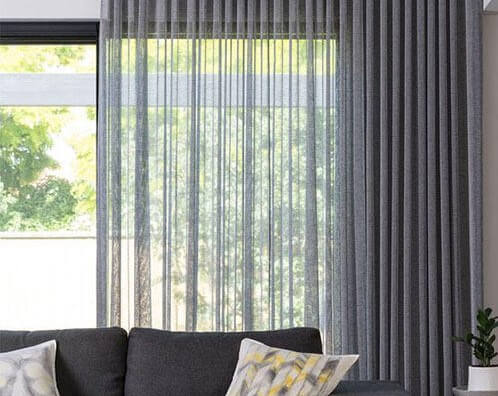
Thin and transparent or semi-transparent materials are used to make sheer curtains. When closed, this curtain lets in the greatest light into the space. Additionally, sheer curtains provide less privacy and don’t have any other function other than being attractive.
The best places for these curtains are in living rooms and dining rooms. Some decorators line sheer drapes with fabric. You may take advantage of the sheer curtains’ beauty as well as the improved seclusion and extra advantages they offer by installing them.
While maintaining much-needed privacy and guarding against pesky insects and dust, sheer curtains are a terrific way to make the most of natural light and create a bright, soft, outdoorsy ambiance. Typically, sheer curtains are made from polyester. Polyester is a very friendly and cost-effective fabric, sheer curtains are also deemed so.
1. b. Blackout Curtains

When closed, blackout curtains only let a very little amount of light into the space. These curtains are produced with thicker materials and frequently include built-in linings. The most private curtains are those with these elements, which frequently go beyond mere decoration. Blackout curtains are often used in theatres, bedrooms, and other spaces where blocking out natural light is essential.
Blackout curtains are sometimes used on top of sheer curtains to add more features and a more upscale appearance than what can be achieved with a basic curtain liner. Blackout curtains help insulate a room, which increases energy efficiency. Due to their thickness, blackout curtains also aid in reducing outside noise. Blackout drapes come in a variety of hues and shapes. This type of curtain is certainly the best if you are in need of privacy as it blocks the view of both sides.
1. c. Semi-Opaque Curtains

Semi-opaque curtains block more light and provide a little more privacy than sheer curtains. When semi-opaque curtains are drawn during the day, you can see the sun lighting the fabric, but you can’t see through them if there are people or objects outside. However, when the lights are on at night, anyone outside might be able to see figures and movements.
Blackout and sheer curtains can be combined to create semi-opaque curtains. Even when closed, these curtains let some light into the space. Additionally, compared to sheer curtains, this form of curtain offers more privacy. These kinds of curtains are a common option for any application and can be hung on a double curtain rod to create more opacity when combined with other curtains.
Based on the attachment style
2.a. Rod Pocket Curtains

Curtains with rod pockets have a pocket sewn into the top of the curtain. You pass the curtain rod through the curtain and out the opposite side of the pocket to hang rod pocket curtains. With a valance, these curtains are popular. They can also be utilized to give a casual appearance without a valance.
Typically, cotton or linen fabrics would look best as rod pocket curtains. Sometimes the pocket is embellished with ruching or embroidery. Rod pocket curtains have a casing that is sewn into the rear of the curtain panel and are sometimes referred to as pole top or casement curtains. This forms a long pocket at the top into which you may insert the curtain rod to conceal it.
2. b. Grommet and Eyelet Curtains

The top of the grommet and eyelet curtains has large eyelets that are reinforced with grommets. Nowadays, curtains with this type of design are very popular. Grommet and eyelet curtains provide you with the option to replace the balance with a stylish flair. Grommet Curtains are the ideal options for curtains you want to open and close frequently due to their simple operation.
They work particularly well for large windows or sliding glass doors since they make it easier to open than those with heavy fabric. The grommet rings generate a rippling effect fold as you feed them onto the rod, so, they form regular pleats without training your drapes. This gives the rod a stunning appearance.
2. c. Tab Top Curtains

When Loops of fabric are stitched into the top of the curtains, they are called tab-top curtains. Through the loops, the curtain rod string is threaded. These curtains may have decorative details like buttons. The most common style for tab top curtains is casual, while they are also utilized in more modern country styles.
Tab top curtains are less formal in appearance than rod pocket curtains. These types of curtains have noticeable loops that are simple to thread through a curtain rod and dangle from the top seam of the panels. Tab-top curtains make a stylish addition to farmhouse or cottage interior design. The top of these drapes has fabric loops that are visible. For an antique look, these encircle the rail and bear the weight of the curtain.
2. d. Hidden Tab Curtains

Rod pocket and tab curtains can be combined to make hidden tab curtains. In this design, the tabs that are used to hang the item are concealed beneath the second piece of cloth, which is typically attractive. A hidden tab curtain’s top cloth is frequently pinched to give some flare. These drapes can be used with or without a valance.
Traditional, rural, or contemporary styles all have a following for hidden tab drapes. Tabs or loops are sewn onto the rear of the curtain header in these types of curtains. Hidden tab curtains are also known as back tab curtains. Both are hidden from view from the front as the rod slides through the tab. This produces a beautiful, clear line and gives the curtain the appearance of floating in space.
Based on length
3. a. Sill Lenght Curtain
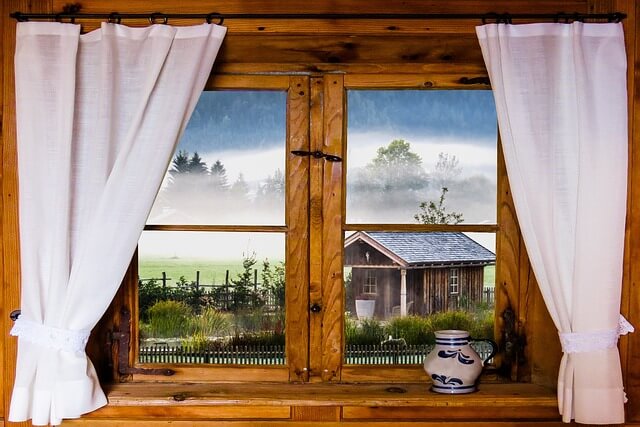
Sill-length curtains are the best options for those windows that you leave open throughout the day. These styles of curtains are a perfect choice for smaller windows or windows of kitchens and bathrooms. Justifying the name, these types of curtains are hung in such a manner that they reach just over the sill level of a window.
Sill-length curtains are generally made to hang in such a way that they stop just over the window sill, they can be hung from the top, from the middle of the window, or from any position of the window, but they always end at the top of the sill or after just cover the sill.
The main feature of these curtains is that they allow light to enter while granting privacy. Due to their length, they allow the light to enter through the open upper side. These curtains are most commonly seen in cafes, where they are fitted with two panels per window.
3. b. Apron Length Curtain

Using an apron-length curtain can help you make the most of the appearance of your windows. Smaller windows, such as those in bathrooms, bedrooms, and even kitchens, are covered with these kinds of curtains. The rod is typically hung a little higher than the window itself, and the curtain typically hangs several inches below the window sill i.e up to the apron or just over the apron.
When drawn, the apron-length drapes might give the impression that your window space is larger than it actually is. 84-inch-long curtains that end a few inches below the window sill. This length is perfect for use in bedrooms, kitchens, or spaces with radiators beneath the windows. To create a traditional, formal impression, use long drapes that extend from your window frame all the way.
3. c. Floor Length Curtain

The sliding doors and floor-to-ceiling windows look stunning with floor-length drapes or curtains. It usually breaks by less than an inch, just above the floor. To give the appearance of a floor-to-ceiling window, floor-length curtains are also preferred for smaller windows that are little or never opened.
Long curtains or drapes that extend all the way to the floor give a conventional, formal appearance. These curtains will fall around 1/4 inch over the floor and are typically between 84 and 96 inches long. They are perfect for dining rooms, living rooms, and other spaces. Read Also: Different Types of Flooring.
3. d. Puddle Length Curtain

Extra-long floor-length curtains are known as puddle-length curtains. They break abruptly on the floor, like the trail of a wedding dress, and are several inches longer than the width of the window. This design is particularly well-liked if you want to make a bold or passionate window decoration.
Puddle-length curtains are the lengthiest and most formal kind, and they normally measure 108 inches or longer. These types of curtains are frequently used in living rooms, formal sitting areas, or houses with high ceilings. There are various ready-to-hang alternatives available in typical curtain lengths that work in many different settings. 63-inch, 84-inch, 96-inch, and 108-inch curtains are frequently available options.
Based on material
4. a. Cotton Curtains
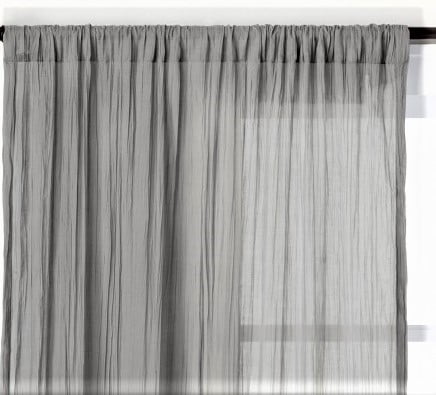
For a variety of uses, cotton curtains are a popular option. Cotton curtains let in a lot of light while still offering a fair amount of privacy because they are semi-transparent. To provide a whole window treatment, cotton curtains are occasionally overlaid with additional materials. Cotton curtains come in a wide variety of designs and are a good option for any room in the house.
They are significantly more adaptable because these types of curtains are simple to clean. To prevent light from entering a structure, these kinds of curtains are frequently hung on the inside of the windows. During the night, these types of curtains promote sleeping by preventing outside light through them and also prevent outsiders from being able to see inside.
4. b. Linen Curtains

Although slightly thicker than cotton curtains, linen curtains or drapes nonetheless exude an air of ease and laxness. Average amounts of light and acceptable amounts of privacy are let in by the linen curtain. Compared to a cotton curtain, a linen curtain may be more challenging to wash or clean.
Since linen has a rough texture and might attract dust, this curtain is typically not the ideal option for dusty surroundings. If a curtain fabric’s label says it’s “100% linen,” you’ll only get linen fibers in that fabric. Surprisingly, these fibers, which come from the flax plant, are hollow in nature. Despite having an open interior, linen fibers offer a firm, sharp feel that gradually softens.
4. c. Velvet Curtains
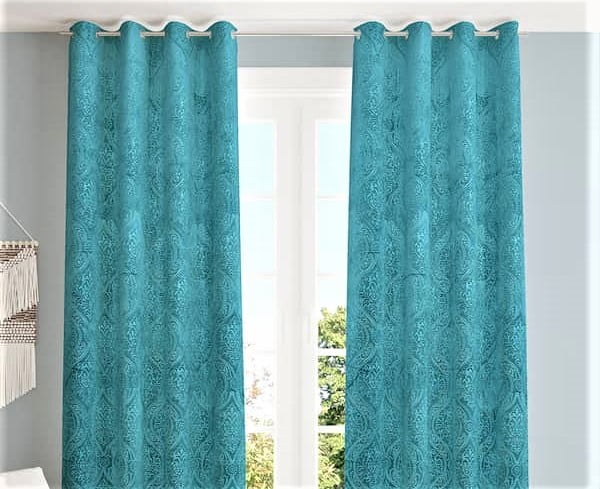
Velvet is another common material for door and window curtains. If you want the maximum seclusion possible, this curtain is the finest option. This thick material also muffles outside noise and prevents breezes. The finest material for bedrooms with light-sensitive sleepers is velvet. Additionally, you may use this unique cloth to give your windows a more dramatic appearance.
Since velvet is hard to clean, curtains made of it are often cleaned by professionals. So, you might want to avoid using this cloth if maintenance is an issue. Velvet is a thick fabric, so, it insulates against the cold, which is useful for draughty windows. It also blocks out light, enhancing privacy and creating the ideal sleeping environment. A velvet curtain is therefore a useful choice.
4. d. Silk Curtains
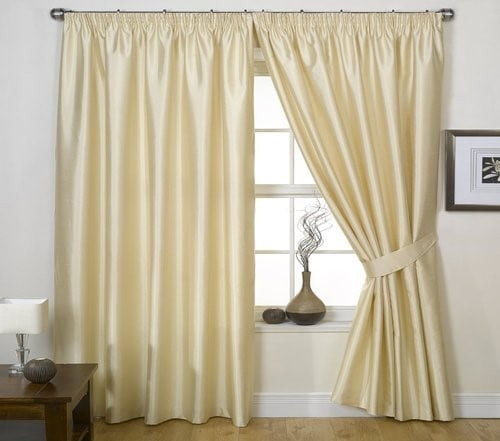
A wide variety of different styles of curtains are made from silk, which is an opulent, fashionable, and fascinating fabric. These types of curtains are commonly used everywhere. It is similar to a semi-transparent curtain and depending on how thick the silk material is, it may let in a lot of light or only a small amount.
In both traditional and modern curtain styles, silk is a common fabric choice. Silk curtains are challenging to clean and frequently need assistance from professionals. The best material for curtains is silk. Even while certain silks appear to be delicate, with appropriate care, they are surprisingly robust and make excellent window cover material.
4. e. Lace Curtains

Being a sheer fabric, lace is a fantastic option if you want to build a window treatment that is light, bright, and breezy. Since these materials let in the most light, lace offers the least seclusion. For kitchens, living rooms, or any other room in your house where you want to let in lots of light, lace is the material of choice.
To create a more adaptable window decoration, lace curtains can also be combined with heavier textiles. Over the years, lace curtains have experienced ups and downs in popularity. Although curtains made of lace are undoubtedly attractive, a modern home may not always be the greatest place for them. In addition to possible style issues, lace is renowned for being fragile. Read Also: 20 + Wall Decor ideas.
4. f. Burlap Curtains
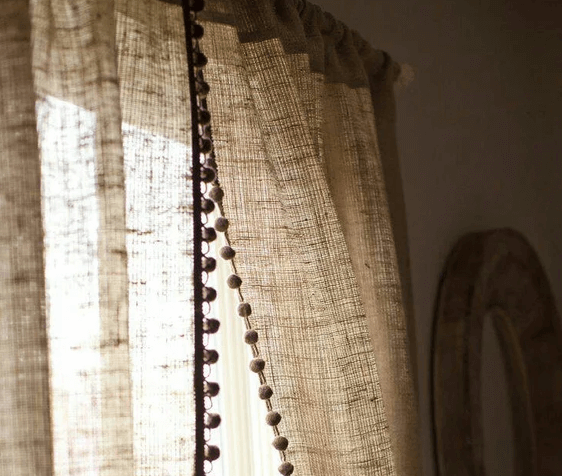
Burlap resembles linen in appearance and texture, although it is thicker and heavier than linen. When you close the curtains, this natural and straightforward fabric offers excellent seclusion while letting in little to no light. Burlap is simple to maintain and attractive in informal settings. You could most certainly line your curtain panels with fabric to block the sun.
There are two burlap curtain panels for each window. Burlap-covered curtains are another excellent choice for achieving a farmhouse look. Burlap which is coarsely woven enables some light to travel through it, making them a decent option for curtains when privacy does not require total darkness from the outside.
4. g. Synthetic Curtains

The manufacture of curtains has become incredibly well-known for synthetic fabrics. Natural fiber curtains cost more to create and are typically harder to clean than synthetic curtains. Curtains made of synthetic fibers can mimic the appearance and texture of any of the natural materials mentioned above. In general, synthetic materials are less expensive than those made of natural resources.
The ideal option for you may therefore be synthetic curtains if cost is a factor in your decision to buy or if you want something that is simple to clean. Polyester curtains are quite sturdy and long-lasting, and they are also incredibly simple to clean! Because it can be used to make a wide variety of curtain styles, polyester is a fantastic curtain fabric.
Based on the hanging type and panel.
5. a. Single Panel Curtains

A single-panel curtain, as the name suggests, has one panel that completely encloses the window. The curtain panel can be tied back to give it a contemporary, asymmetrical appearance. It can be pulled open from either side. These curtains combine a contemporary design with a timeless aesthetic, making them ideal for most ornamental settings.
A single curtain panel is a far more beautiful option for windows with a smaller opening where a double curtain would be too much. They can be hung on the right or left side of the window with the tie. Pair them with two windows to attract attention to the center of the wall. They can be in the manner of a roman shade or hanging directly down from the bar. It also comes with a variety of choices in fabric.
5. b. Double Panel Curtains

Two independent curtain panels make up a panel pair. In these types of curtains, both traditional and temporary designs of curtains are popular. You can hang a curtain on either side of the window by utilizing a panel pair. You must draw each curtain strip together to close the curtains. Panel pair drapes or curtains are folded back to give your window a symmetrical appearance.
Larger windows necessitate more material for covering. Although there are larger single panels available, double curtain panels could be preferable. You can simply cover the entire window if you want to, or only pull on one side if you need to uncover half portion of the window, giving you more control over how much of the glass is covered. There are times and situations when double-panel curtains can also cost less than single panels.
5. c. Valance Type Curtains
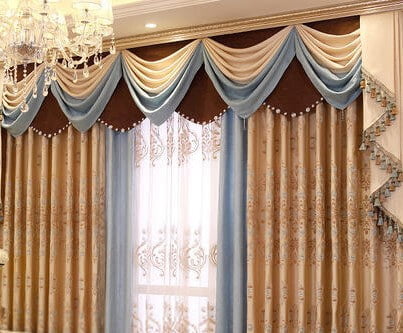
Generally, these short drapes dangle from the top of the window. The window’s valance is an additional decorative element. This popular Victorian element of interior design is often used alongside blinds and Panel curtains. Panel curtains and valances can be purchased separately or as a set.
If your windows have blinds, you can also use valance-style curtains in place of curtains. Valances are good and preferable in terms of appearance if you don’t like complete curtains. It will give the window a lovely flair. Although valances can be used on their own, they are frequently hung-over windows with curtains or drapes to properly frame the windows.
They are frequently used in living areas as decorative pieces. Valance curtains are further classified according to their design, they are like – Swag Valances, Scarf Valances, Balloon Valances, Ascot Valances, etc.
5. d. Window Treatment Set

The window treatment set is nothing but a completely customizable set of everything that you need to complete your window treatment. The most common sets include two full curtains, one rod, and one valance; in some instances, they come with tiebacks or curtain rods, or even pelmets.
The hard treatment type which comes with setups made of wood or aluminum or vinyl also comes with window blinds accompanied by Louvre. These types of treatment sets allow the user to enjoy the beauty of the windows and are completely customizable to make the set feel like a part of the room and to get a sensation of familiarity.
5. e. Window Tier Curtains

The majority of the time, kitchen windows or windows whenever you want privacy but still want the light to come in, are covered with window tier curtains. They only cover the bottom half of the window, leaving the top uncovered. Tier curtains are also known as cafe curtains. They allow light to enter through the top of the window while granting privacy.
Cafe curtains are normally fitted with two panes per window, just like the majority of curtains or drapes. When additional light is needed, the panels can be moved to the side or entirely closed over the bottom part of the window. Although there are different color and pattern options, white is the most typical color used historically. Read Also: Best Colors For Living Room.
5. f. Liner Curtains
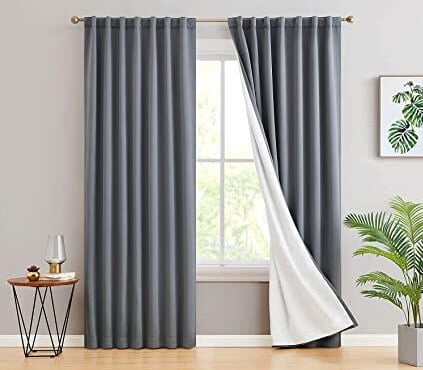
Curtain liners are such a wonderful complement to the curtains. Liners are frequently used to increase the adaptability of curtains. Many homeowners blend sheer curtains with liners, giving them extra options for privacy and daylighting. Curtain liners also offer supplementary benefits. They may be thermally insulating or noise-reducing, for example.
The best fabrics which are used for curtain lining are cotton, polyester, and polycotton. It is fastened to the rear of the curtain. Knowing what kind of lining will work best for your needs is essential whether you want a fuller-looking curtain or need curtains to filter out sunlight. Additionally, lining gives curtains shape and protects the cloth on the front.
5. g. Scarf Valance Curtain

Scarf Curtain is a type of valance curtain. This particular style of curtain has a long, thin fabric dangling from the window’s top. It produces a striking impression and adds refinement to the space. Window scarfs are installed either from a curtain placed at the top of the window or by sandwiching it in between two wall brackets.
Window scarves are excellent options for window decoration, they are attractive, adaptable, and still allow for a lot of natural light to enter the space where they are being used, these features them worthy of mention in homes.
5. h. Roller Curtains
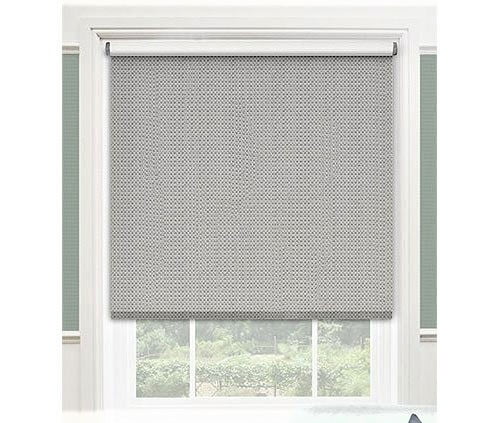
Roller Curtains are a particular style of curtain that rolls up into a cylinder at the top of the window. Pulling on the curtain or a looped cord causes it to roll up and down. They have a lot of benefits and are simple to use. Roller curtains are also very simple to clean and maintain, and they have a very classic appearance. This type of curtain doesn’t occupy any space on both sides of the windows, hence, increasing the vision area through the windows. They look fantastic in any room because they are available in so many different colors, fabrics, and patterns.
There are currently even motorized roller curtain options in addition to the traditional options of corded roller curtains. You can operate the motorized curtains with a remote control rather than physically pulling them up or down. Simply pressing a button will operate the motorized curtains. This can help you save time in the morning and evening, especially in homes with a lot of windows. For windows that are difficult to access, motorized curtains are a great option because they eliminate the need for step stools to reach the cords. They are also the ideal option for those who find it difficult to reach windows or for elderly or disabled people who struggle to open curtains.